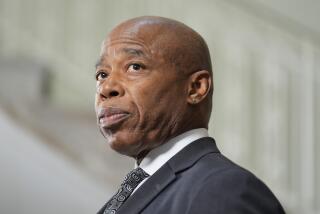Spending Spree Ends : Boom or Bust--Alaska Is Unique Land
In Alaska, the prime topic of conversation is Alaska.
It’s as though the people up here wanted confirmation that they weren’t nuts to live in a land whose character is shaped by weather and isolation. They ward off their doubts by wrapping myths around their Last Frontier and they delight in referring to far-off “America” as if it were a foreign country, which in many ways it is.
Half Live in Anchorage
Book after book about sourdoughs, lost patrols and gold miners celebrates the toughness of the Alaskan spirit. But, in fact, half of all Alaskans live in Anchorage, a charmless city of 250,000 residents where helicopters now provide rush-hour traffic reports. And some Alaskans, talking about Alaska, complain that a decade of easy oil money in the boom years softened the state’s collective character and left citizens too spoiled to deal well with the crash of oil prices.
The Anchorage Daily News calls its Sunday magazine “We Alaskans,” although one-third of the population has arrived since 1980 and almost everyone except the Eskimos and Indians came from somewhere else. And last month a new magazine entitled “Alaska Men” premiered, saying the state had “an abundance of interesting and exciting men whose rugged individualism, spirit and vitality makes them unique among men of the world.” Among those profiled were a fireman, a salesman, a magician and a bagpipe player.
Longevity Counts
If prestige is equated with money in Los Angeles, with political power in Washington, D.C., and with family heritage in Boston, then what counts in Alaska is longevity. It is longevity that separates the cheechako-- Chinook jargon for someone who is dumb, greedy and newly arrived--from the old-timers, who six years ago tried to push through the Legislature a bill that would have imposed an income tax exclusively on newcomers. The old-timers have roughed out a decade or two of horrible winters, have lived through the boom and bust of the oil bonanza and have accepted the fact that if Alaska were in Africa or Latin America, it would be considered the Third World.
Juneau, Alaska’s capital, is reachable only by plane or boat--not car--and frozen rivers provide a winter network of roadways for scores of towns and villages that in summertime are roadless. Alaska, the nation’s largest, most sparsely populated, best educated and youngest (median age 26) state, has fewer miles of road than Vermont. Sewerage systems and flush toilets remain rarities in much of the outback, and when some newspapers in America criticized the state’s frenzied spending of oil-revenues to build an infrastructure a few years ago, then-Gov. Jay S. Hammond complained: “Before you try to dock us on the presumption that we’re about to gold-plate the plumbing, at least permit us to first replace the outhouse.”
Many outhouses have indeed disappeared, but Alaskans remain struck by how other Americans still view their state as the Great Beyond--a not unreasonable assumption since Tokyo is only two hours farther away by jet than Los Angeles, the 154 Alaskans who live on Little Diomede Island are less than three miles from the Soviet Union, and one can catch a daily non-stop flight from here to London but not to New York or Washington. “You use U.S. postage? How odd,” said a tourist mailing a post card at the Hilton Hotel the other day.
“I’ve stopped telling strangers I meet in the Lower 48 that I’m from Alaska because it just stops the conversation,” said Staples Brown, a mechanical engineer who moved here from Maine in 1965. And former Gov. Walter J. Hickel, who came here in 1940 from Kansas, has stopped justifying his residency in Alaska in terms of the state’s great natural beauty. Now he tells people he lives here “because I dislike Alaska less than any place I’ve ever been.”
The conversation in Alaska about Alaska this summer has been sobering on two scores:
Free Ride Ends
First, the new Democratic governor, Steve Cowper--whose cowboy boots, Marlboro-man good looks and taciturn manner have earned him the nickname The High Plains Drifter--has been telling Alaskans that the free ride is over and that lower oil prices have ended the state’s Saudi Arabian-style spending spree.
Second, in Anchorage and most other population centers, there really hasn’t been any summer at all this year, just heavy, dark clouds, rain and chilly “temps.” (Alaskans talk about the temperature so often that they have shortened the word.)
“Hello, Alaska,” taunts one television ad, “are you looking for summer? Then come to Hawaii.” Christmastime flights to Hawaii already are sold out, and during a baseball game in Palmer the other evening the fans’ loudest cheers went not to the hometown players but to the sun, which peeked timidly out of the cloud layer for a few precious seconds at 10 p.m.
But Alaskans are described--by Alaskans--as traditional optimists, and whether it’s the weather or the economy, there is a belief here that the return of good fortune is just a matter of waiting out the storm.
“This state’s always been boom or bust and we’ll boom again,” said Bill (Wee Willie) Walley, Fairbanks mayor and radio talk-show host.
Still, it is undeniable that the collapse of oil prices--from which Alaska receives 86% of its revenues--has made the state a little less introverted and a bit more humble.
When the oil boom of the mid-1970s attracted new immigrants by the thousands and a get-rich-quick mentality gripped the state, bumper stickers around Alaska said: “Happiness is 10,000 Texans heading south with an Okie under each arm.” Now the sign on the cash register at the Sleazy Waterfront Bar in Fairbanks pleads, “Please God, give us one more boom. We promise not to p--- this one away.”
Whether Alaska spent its godsend--$24 billion in oil royalties over 10 years--wisely or foolishly is still a subject of debate. But spend it did. “Money was shoveled into the state as though there were no tomorrow,” said Edward Rasmuson, board chairman of the National Bank of Alaska. Unlike Texas, Alaska’s oil reserves are publicly owned, so rather than creating a bunch of rich Ewings, Alaska basically engendered a whole moneyed class. There were so many dollars around that one state representative, Hoyt (Pappy) Moss, proposed bailing out Chrysler, Cleveland and almost everyone else with financial difficulties in the Lower 48.
More than $76 million was spent on a high school in the North Slope Borough--a region the size of Minnesota with a population of 6,000--and $100 million went to study the proposed construction of two Susitna River dams, which were never built. Alaska put $4 million into a grain export terminal in Seward, then abandoned it. Fairbanks paid its city engineers $75,000 a year, its grade school teachers $42,500 and hired a full-time employee to name streets. In northernmost Barrow, where the borough government accounts for 95% of the employment, the new Town Hall cost $12 million. Barrow’s 2,200 inhabitants were so overtaken by the euphoria of sudden wealth that the borough is now $1.3 billion in debt, a larger deficit than Alaska itself has managed to ring up.
Attracts Retirees
Although Alaska did turn down a Dade County, Fla., official requesting a $200-million grant to build a sports complex, the Legislature dispensed largess in a manner befitting King Fahd of Saudi Arabia. It repealed state income taxes in 1981, and in order to keep retirees in the state, it gave all persons over 65 a monthly bonus of $250, in addition to paying their property taxes and providing them with free bus passes and fishing licenses. The result was that the giveaway attracted new retirees from the Lower 48 and what started as a $4-million annual program now costs Alaska $70 million. With Alaska envisioning a $184-billion surplus by the year 2000, the Legislature set up a Permanent Fund--similar to the Fund for Future Generations in Kuwait--that pays residents a dividend every year.
“It was bizarre--really wild,” said Lou Cancelmi, a Seattle-based Alaska Airlines executive who then lived in Anchorage. “My wife goes out to the mailbox one day and comes back with checks from the state for $5,000--$1,000 for each member of the family. Not only wasn’t the state taxing you, it was paying you to live in Alaska.”
But in 1985 oil prices tumbled and the boom ended. Alaska had a net population gain from immigration of 30,000 in 1975; this year it will have a loss of about 15,000. The prostitutes who once paraded on 2nd Avenue in Fairbanks have returned to the Lower 48, the state payroll will lose a projected 2,000 employees this year, unemployment is over 11% and homeowners in Anchorage speak of having “negative equity,” a euphemism for owing more on a house than it is worth.
“I think you could characterize the business community last year as having been shell-shocked,” said Anchorage realtor Duane Heyman. He has put his own house, complete with indoor swimming pool, on the market to cut overhead and is asking less than half of what it was appraised at two years ago. “People saw things crumbling around them, and it took a while to register what was happening. They just sat around numb,” he said.
To be sure, Alaskans remain a hearty, independent-minded people who oppose socialism--except as their own Legislature applies it--and who embrace their handsome, empty land with the passion of a first love. But few doubt that the strength of the Alaskan fiber has been tested and weakened by having had so much so easily.
“We got greedy,” said Cliff Eames of the Alaska Center for the Environment. And Howard Weaver, managing editor of the Anchorage Daily News, adds: “One of the effects of all that money was to erode the character of the people. There’s kind of a whiney, spoiled quality in Alaska now that wasn’t here when I came 12 years ago.”
Economy’s ‘Darn Good’
Even though Gov. Cowper has had to wrestle with a $882-million budget deficit, economists believe Alaskans have much to be thankful for. The fishing industry, worth $752 million annually, is booming; tourism is at record levels and will reach 800,000 visitors this year; the presence of the U.S. military brings $1.3 billion to the state, and stable federal jobs account for one-fifth of total employment; oil revenues totaled $1.27 billion last year, second only to Texas; the Permanent Fund, which now tops $8.1 billion, earned every Alaskan an annual dividend of $781 in July.
“There’s nothing wrong with the economy in Alaska; in fact, it’s darn good,” said Rasmuson, the banker, before leaving his office early one afternoon to fly his plane south to the Kenai Peninsula where he would fish for salmon until the shadows of dusk descended at about midnight. “Those who can afford to live with the present conditions for a while will end up doing quite well. Those who are using their savings to get through the rough times aren’t going to make it.”
Cowper, 48, a North Carolinian lawyer who covered the Vietnam War as a free-lance journalist and moved to Alaska in 1968, is the first to admit that his austerity moves have caused an outcry. “But basically I don’t think we should pay people to live in Alaska,” the governor said.
He has proposed reintroducing the income tax, restricting the retirees’ bonus on a basis of need, ending the forgiveness of students who don’t re-pay education loans and taking money from the Permanent Fund to reduce the deficit. He found, however, that as oil prices rose this summer, “the willingness on the part of the Legislature to address the issues began to sink.”
Even so, state spending is now only 55% of what it was two years ago and Cowper continues to remind Alaskans that the “hysterical optimism” of the boom years has no place in 1987.
Most Alaskans--or at least those who plan to stay and ride out the economic downturn--mourn the end of easy money, but not the passing of the frenzied boom itself.
The boom brought massive unplanned development, a plethora of government regulations and moneyed values that seemed to belong more to California than to the Last Frontier. These were all things the new Alaskans had tried to escape when they fled the Lower 48. But, as they point out, the country is still beautiful and wild and there’s lots of it, and Alaskans continue to find satisfaction in being different, in being perched here in the attic of the United States, a world unto themselves.
As a T-shirt in Kodiak says: “This may not be the end of the world, but you sure can see it from here.”
More to Read
Sign up for Essential California
The most important California stories and recommendations in your inbox every morning.
You may occasionally receive promotional content from the Los Angeles Times.










